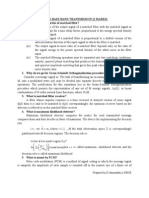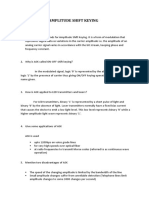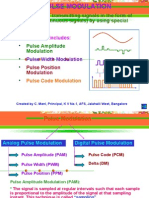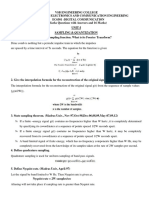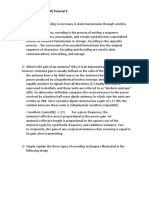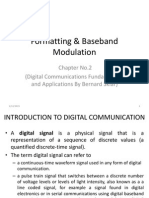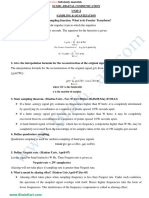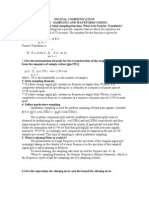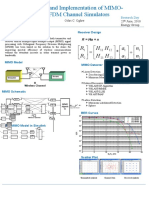It404 Adc Viva Qa
It404 Adc Viva Qa
Uploaded by
ankurshrivastavaCopyright:
Available Formats
It404 Adc Viva Qa
It404 Adc Viva Qa
Uploaded by
ankurshrivastavaOriginal Title
Copyright
Available Formats
Share this document
Did you find this document useful?
Is this content inappropriate?
Copyright:
Available Formats
It404 Adc Viva Qa
It404 Adc Viva Qa
Uploaded by
ankurshrivastavaCopyright:
Available Formats
1. What are the disadvantages of Analog communication?
Its not reliable, Noise effect is more on the signals, Power required for signal transmission also more, Circuit
complexity is more and costly.
2. What are the Advantages of Digital Communication?
Reliable, Noise effect is very less, power consumption is very less, various Digital ICs are available so
circuits not complex , cheap, Error detection and correction is also possible.
3. What are different types of digital modulation?
ASK, FSK, PSK, PCM, DPCM,Delta modulation, Adaptive Delta modulation etc..
4. How to convert an analog signal into digital signal?
Blocks: Anti aliasing filter, Sampler, Quantizer, encoder.
5. Define the functionality of Sampler, Quantizer?
Sampler: converts a continuous time signal into discrete time signal.
Quantizer: converts continuous in amplitude signal into discrete in amplitude signal.
6. What are some Coding techniques?
Pulse code modulation, Differential pulse code modulation, Delta modulation, Adaptive delta modulation.
7. What is Sampling?
Converting a continuous time signal into discrete in time signal is called as Sampling (similar to cutting a
bread into slices)
8. Define Sampling theorem?
To reconstruct the Continuous time signal from discrete time signal ,the sampling frequency should be more
than equal to twice of Continuous time signal frequency(max).
9. What is Nyquist Rate?
If the sampling frequency is twice of Continuous time signal frequency(max), then that is called as Nyquist
rate.
10. How many types of samplings are their? Explain briefly?
Impulse Sampling, Natural sampling, Flat top sampling.
11. What is aliasing effect? How to overcome it?
Due to imperfect sampling the signals will be interfered in frequency domain i.e called aliasing effect in
sampling. if sampling theorem satisfied in sampling or first by passing signal from anti aliasing filter before
sampling then aliasing effect will be reduced
12. What are the Analog pulse modulation methods?
Pulse amplitude modulation, pulse width modulation and pulse position modulation..
13. Define Pulse amplitude modulation?
The carrier pulse height (amplitude) proportional to amplitude of messege signal.
14. Define Pulse width modulation?
The carrier pulse width proportional to amplitude of message signal.
15. Define Pulse position modulation?
The carrier pulse position proportional to amplitude of message signal.
16. Compare PAM, PWM, PPM?
17. What is Amplitude shift Keying (ASK) ?
It represent the digital data as variations in amplitudes in carrier wave. i.e '1' represented by transmitting a
fixed amplitude carrier wave for the bit duration with constant frequency.
18. What is Phase shift keying ( PSK)?
It represent the digital data as variations in phase shift in carrier wave. i.e '1' represented by 0 phase shift
carrier wave , where '0' represented as 180 phase shift incarrier wave for the bit duration with constant
frequency
19. What is Frequency shift keying (FSK) ?
It represent the digital data as variation in frequency in carrier wave, i.e for '1' more than carrier frequency ,
for '0' less than carrier frequency.
20. What is Binary Phase shift Keying (BPSK) ?
for each one bit of binary data (0 & 1) carrier phase will be changed (two different shifts: 0, 180)
21. What is Quadrature Phase shift Keying (QPSK) ?
for each two bits of binary data (00,01,10 & 11) carrier phase will be changed (four different shifts : 45, 135,
-45, -135)
22. What is the difference between Bit Rate and Baud Rate?
Bit rate represents Bits per sec,Baud rate represents no. of symbols per second i.e. in communications the
no. of bits transmitted per sec is called as Bit Rate (units bps) and The no. of times a signal (here carrier)
changes its state (change in freq, phase, amplitude) per sec is called as Baud rate.
23. What is bandwidth of BPSK signal?
2Fc, if Fc represents carrier frequency
24. Compare ASK, PSK and FSK.?
Bandwidth: ASK< PSK < FSK
Power: ASK <PSK = FSK
Probability of error: ASK > PSK > FSK
Signal to Noise Ratio: ASK < PSK < FSK
25. Why is ASK called as ON-OFF keying?
When input data is 1 then output is carrier, if input is 0 out put is zero. so its looks like a switch which will
switch on when input is 1 and off when input is zero
26. Define Pulse code modulation?
Each and every quantized samples will be encoded with sequence of zeros and ones with 'n' bits within
sampling interval (Ts), So the bit duration will be Ts/n. as no. of bits (n) increases error decreases but
bandwidth increases.
27. How bits are needed to encode N different levels?
Log2 N
28. Define step size?
It is the difference between two successive no.s (levels), i.e. voltage difference between one digital level
and the next digital level. (Ex: 000 & 001, 1011 & 1100)
29. How to calculate Step size in PCM?
step size(Δ) = (VFS-Vmin)/L
where L =2n, n = no. of bits, VFS = full scale voltage
30. Define Quantization error?
It is the difference between sampled signal and Quantized signal.
31. What is the max value of Quantization error?
Half of the Step size.
32. What are the applications of PCM?
computer Disk, Digital Telephony, Digital Audio Applications, etc.
33. What are the disadvantages of Pulse code modulation?
To get less Quantization Noise no. of bits should be increased, then bandwidth will be increased. So we have
to compromise with either Quantization error or bandwidth.
34. Define Differential pulse code modulation?
In DPCM, The difference between the consequent samples will be encoded with sequence of zeros and ones.
35. Why DPCM is better than PCM?
Instead of encoding each sample, Its better to encode the difference between samples then Quantization error
will be minimized with less no. of bits, then bandwidth also get decreased.
36. Define Delta modulation? Why it is better?
It is same as DPCM with no. of bits to encode is one bit only (either 0 or 1). by this bandwidth will be
decreased.
37. What is granular noise? Define slope overload?
The Delta modulation is efficient when and only when signal is varying continuously with less variations. if
signal varies suddenly then we get two different Noises. those are slope overload and granular noise
38. When granular noise and slope overload occur in Delta modulation?
Granular Noise: Δ / Ts > slope of signal
Slope Overload Noise: Δ / Ts < slope of signal
39. What is Adaptive Delta Modulation and what are the advantages?
If the step size varies according to the slope of the signal then that is called as Adaptive Delta modulation.
granular and slope over load noise will be desuced.
40. Compare all Digital pulse modulation techniques (PCM, DPCM, DM, ADM)?
41. What is multiplexing? How many types of multiplexing possible in communication?
Combining two or more signals to pass through a channel is called as multiplexing.
The different Multiplexing techniques are:1) Frequency division Multiplexing, 2) Time division
Multiplexing, 3) Wavelength division multiplexing, 4) Orthogonal frequency division multiplexing.
42. Define ISI (Inter symbol Interference)?
It is a Distortion in digital signal that one symbol interferes with other symbol.
43. What is Matched filter?
It is an optimal linear filter for maximizing the SNR (Signal to Noise Ratio) in the presence of additive
random noise.
44. What is the cause of inter symbol Interference (ISI) and it can be reduced?
ISI caused by multipath propagation and inherent non linear frequency response of channel. It can be
reduced by pulse shaping.
45.What is multipath Interference?
When a signal reaches to transmitter in various paths then delays exist in each path so at receiver all delayed
signals will be received, then original signal will be interfered by its delayed versions. That is called
multipath interference.
46. What is frequency synthesizer?
it is an oscillator which can generate any range of frequencies.
47. What are the features of Code Division Multiple Access?
The CDMA technique is more secure communication over all, this is used in military, If we know the code
which is used to encode the data, then only we can receive the data. But No. of users are limited (depends on
code length)
48. Explain about Frequency Division Multiple Access?
In FDMA Spectrum is divided into segments and each segment is permanently assigned to each transmitter.
so to get more efficiency in using spectrum, each signal bandwidth should be less and perfect modulation
technique should be used.
49. Explain about Time division Multiple Access?
In this a fraction of time slot will be assigned to each transmitter, so as no. of transmitters increases
complexity increases. for this perfect synchronization is required.
Q1 Explain PAM?
A1Pulse-amplitude modulation, acronym PAM.PAM, is a form of signal modulation where the message
information is encoded in the amplitude of a series of signal pulses.
Q2 Give example PAM?
A2Example: A two bit modulator (PAM-4) will take two bits at a time and will map the signal amplitude to
one of four possible levels, for example −3 volts, −1 volt, 1 volt, and 3 volts.
Q3Where PAM is used?
A3Pulse-amplitude modulation is widely used in baseband transmission of digital data, with non-baseband
applications having been largely superseded by pulse-code modulation, and, more recently, by pulse-
position modulation.
Q4What is PPM?
A4.Pulse-position modulation (PPM) is a form of signal modulation in which M message bits are encoded
by transmitting a single pulse in one of 2 M possible time-shifts. This is repeated every T seconds, such that
the transmitted bit rate is M/T bits per second. It is primarily useful for optical communications systems,
where there tends to be little or no multipath interference.
Q5 Explain PWM?
A5 Pulse-width modulation (PWM) is a commonly used technique for controlling power to inertial electrical
devices, made practical by modern electronic power switches.
Q6 define Duty cycle?
A6The term duty cycle describes the proportion of 'on' time to the regular interval or 'period' of time; a low
duty cycle corresponds to low power, because the power is off for most of the time. Duty cycle is expressed
in percent, 100% being fully on.
Q7Explain principal of PWM?
A7Pulse-width modulation uses a rectangular pulse wave whose pulse width is modulated resulting in the
variation of the average value of the waveform.
Q8 what is the use of Delta modulation for PWM control?
A8 the use of delta modulation for PWM control, the output signal is integrated, and the result is compared
with limits, which correspond to a reference signal offset by a constant. Every time the integral of the output
signal reaches one of the limits, the PWM signal changes state.
Q9 what is the use of Delta sigma modulation for PWM control?
A9 In delta-sigma modulation as a PWM control method, the output signal is subtracted from a reference
signal to form an error signal. This error is integrated, and when the integral of the error exceeds the limits,
the output changes state.
Q10 Compare PPM and M-FSK?
A10 PPM and M-FSK systems with the same bandwidth, average power, and transmission rate of M/T bits
per second have identical performance in an AWGN (Additive White Gaussian Noise) channel. However,
their performance differs greatly when comparing frequency-selective and frequency-flat fading channels.
Whereas frequency-selective fading produces echoes that are highly disruptive for any of the M time-shifts
used to encode PPM data, it selectively disrupts only some of the M possible frequency-shifts used to
encode data for M-FSK. Conversely, frequency-flat fading is more disruptive for M-FSK than PPM, as all
M of the possible frequency-shifts are impaired by fading, while the short duration of the PPM pulse means
that only a few of the M time-shifts are heavily impaired by fading.
Q11 What is the main advantage of PWM?
A11 The main advantage of PWM is that power loss in the switching devices is very low. When a switch is
off there is practically no current, and when it is on, there is almost no voltage drop across the switch. Power
loss, being the product of voltage and current, is thus in both cases close to zero.
Q12. What is Sampling? What is Sampling Theorem?
Ans: Sampling is defined as the process in which an analog signals are converted into digital signals. It
means that a continuous time signal is converted into a discrete time signal.
Sampling Theorem is defined as : ’The continuous time signal that can be represented in its samples and
recovered back if the sampling frequency (fs) is greater than the maximum frequency of the signal (fm) that
is fs >2fm’.
Q13. Define PAM and write down its drawbacks?
Ans: Pulse Amplitude Modulation is the process by which the amplitude of the regularly spaced pulses
varies according to the the amplitude of the modulating signal.
The drawbacks are:
a. Since the amplitude of the pulses varies therefore the peak power of the modulating s/g is much greater.
b. The bandwidth required for transmitting is greater since the amplitude varies.
Q14. What is Modulation? What happens in over modulation?
Ans: Modulation is defined as the process in which some characteristics of the signal called carrier is varied
according to the modulating or baseband signal. For example – Amplitude Modulation, Phase Modulation,
Frequency Modulation.
In case of over modulation, the modulation index is greater than one and envelope distortion occurs.
Q15. What do you mean by Nyquist rate?
Ans: In case of Nyquist rate, the sampling frequency is equal to the maximum frequency of the signal and
therefore the successive cycles of the spectrum does not overlap.
Q16. What do you mean by FM and classify FM?
Ans: Frequency Modulation can be defined as the frequency of the carrier (wc) is varied acc. to the
modulating signal about an unmodulated frequency.
FM are of 2 types:
a. Narrowband FM
b. Wideband FM
Q17. What is under sampling?
Ans: Under sampling is also known as aliasing effect in which the the sampling frequency is less than the
maximum frequency of the signal and therefore the successive cycles of the spectrum overlap.
Q18. State the advantages of superheterodyning?
Ans: The advantages are:
a. High selectivity and sensitivity.
b. No change in Bandwidth that is bandwidth remains same all over the operating range.
c. High adjacent channel rejection.
Q19. What is multiplexing? Name the types of multiplexing?
Ans: Multiplexing is defined as the process in which a number of message signals are combined together to
form composite signals so that they can be transmitted through the common channel.
The two types of multiplexing are:
a. Frequency Division Multiplexing: In this technique, fixed frequency bands are allotted to every user in the
complete channel bandwidth. Such frequency is allotted to user on a continuous basis.
b. Time Division Multiplexing: When the pulse is present for the short time duration and most of the time
their is no signal present in-between them than this free space between the two pulses can occupied by the
pulses from other channels. This is known as Time Division Multiplexing.
Q20. What is Amplitude Modulation?
Ans: Amplitude Modulation is defined as the process in which the instantaneous value of the amplitude of
the carrier is varied according to the amplitude of the modulating or base band signal.
Q21. How can be aliasing be avoided?
Ans: Aliasing can be avoided if:
a. Sampling frequency must be greater than the frequency of the modulating signal.
b. The frequency should be band limited to maximum frequency of the signal(fm) Htz.
c. If pre-alias filter is used.
You might also like
- 8442 - Mettler Toledo Technical ManualDocument139 pages8442 - Mettler Toledo Technical Manualjulio1979100% (1)
- M7C Controller User DocumentationDocument100 pagesM7C Controller User DocumentationFabianoNo ratings yet
- Aviat ODU 600 DatasheetDocument2 pagesAviat ODU 600 DatasheetsamoweidaNo ratings yet
- DCDocument4 pagesDCharsha0931reddyNo ratings yet
- Unit Iii - Part-A: Course Material (Question Bank)Document5 pagesUnit Iii - Part-A: Course Material (Question Bank)Saravana KumarNo ratings yet
- Ec51 Digital CommunicationDocument18 pagesEc51 Digital CommunicationvijayprasathmeNo ratings yet
- Unit 1 (Pulse Modulation)Document27 pagesUnit 1 (Pulse Modulation)Umarr A SesayNo ratings yet
- 2 Marks All Units Individual DCDocument15 pages2 Marks All Units Individual DCAathi KannanNo ratings yet
- Short Questions of Digital Communication: Unit 1: Pulse ModulationDocument7 pagesShort Questions of Digital Communication: Unit 1: Pulse ModulationSakib AhmedNo ratings yet
- Chapter Five: Topics Discussed in This SectionDocument39 pagesChapter Five: Topics Discussed in This SectionSolomon Tadesse AthlawNo ratings yet
- (95662737) DC 2marksDocument28 pages(95662737) DC 2marksYuvaperiyasamy MayilsamyNo ratings yet
- 2 Marks - 1 UnitDocument5 pages2 Marks - 1 UnitSivaselva GanabathiNo ratings yet
- Analog and Digital CommunicationDocument15 pagesAnalog and Digital CommunicationEASACOLLEGENo ratings yet
- DC Lab VivaDocument5 pagesDC Lab VivaAbir HoqueNo ratings yet
- SyE2_chap2Document25 pagesSyE2_chap2marnevedant49No ratings yet
- 18tel67 CTSDocument5 pages18tel67 CTSChandu ChittiNo ratings yet
- DC 1Document28 pagesDC 1Jeyakumar VenugopalNo ratings yet
- PCS Viva QADocument7 pagesPCS Viva QAtanushtilokchandaniNo ratings yet
- Wa0002Document4 pagesWa0002nitish debbarmaNo ratings yet
- DC CheatsheetDocument2 pagesDC CheatsheetRashi SinghNo ratings yet
- 35 Viva Questions and Answers For Digital Communication SystemsDocument5 pages35 Viva Questions and Answers For Digital Communication Systemsmahimvyas205No ratings yet
- DC Two MarksDocument16 pagesDC Two MarkssubbuNo ratings yet
- Data CommunicationDocument4 pagesData Communicationkaca011No ratings yet
- Amplitude Shift KeyingDocument14 pagesAmplitude Shift KeyingSiva PrrasathNo ratings yet
- Electronics: PHYS4008Document32 pagesElectronics: PHYS4008mr memory formomNo ratings yet
- Digital TransmissionDocument12 pagesDigital TransmissionOrlando BangayanNo ratings yet
- ADC Unit-5Document30 pagesADC Unit-5satyendrainv10No ratings yet
- EC2307 QuestionsDocument7 pagesEC2307 QuestionsAsokan ChinnasamyNo ratings yet
- DCS - Sampling and QuantizationDocument31 pagesDCS - Sampling and QuantizationAhsan FawadNo ratings yet
- Unit - I Digital Communication SystemDocument33 pagesUnit - I Digital Communication SystemAnandhi SrinivasanNo ratings yet
- Analog and Digital CommunicationDocument16 pagesAnalog and Digital Communications.reeganNo ratings yet
- Oral Questions PCSDocument14 pagesOral Questions PCSaishwarya patilNo ratings yet
- DC (UNIT -II)Document40 pagesDC (UNIT -II)singhsahab5027No ratings yet
- Iii Part A BDocument115 pagesIii Part A BDivya SreeNo ratings yet
- 1-Pulse ModulationDocument10 pages1-Pulse Modulationbibekkumar 9178No ratings yet
- Digital Communication: Subject Name:Digital Communication Prepared by:S.Sathiya Priya AP/ECEDocument25 pagesDigital Communication: Subject Name:Digital Communication Prepared by:S.Sathiya Priya AP/ECESathiyapriya ShanmugasundaramNo ratings yet
- Digital Modulation TechniquesDocument34 pagesDigital Modulation TechniquesAkash ModiNo ratings yet
- Activity No. 3 Pulse Code Modulation: Perez, Patricia Grace P. Student Number: 201912327 Bscpe 3-1 Cpen 80Document5 pagesActivity No. 3 Pulse Code Modulation: Perez, Patricia Grace P. Student Number: 201912327 Bscpe 3-1 Cpen 80Patricia Grace PerezNo ratings yet
- DDC ReviewerDocument5 pagesDDC Revieweraloquinchristellrose93No ratings yet
- Tutorial 5 39191Document7 pagesTutorial 5 39191ujjwal poudelNo ratings yet
- Digital Communication IntroductionDocument69 pagesDigital Communication IntroductionlokeshwarrvrjcNo ratings yet
- Sampling and Baseband ModulationDocument65 pagesSampling and Baseband ModulationAbdul Qawi Ansari100% (1)
- Digital Modulation TechDocument63 pagesDigital Modulation Techgaurav_juneja_4No ratings yet
- DC Part ADocument17 pagesDC Part Apavithra PNo ratings yet
- PCS VivaDocument4 pagesPCS VivaMukul MukulNo ratings yet
- Digital Communication Two Marks Q&aDocument29 pagesDigital Communication Two Marks Q&ashankar70% (10)
- Ec8395 2marks OnlyDocument11 pagesEc8395 2marks OnlyGeetha100% (1)
- 1.fundamental Concepts of Digital Communications - Part1of2Document136 pages1.fundamental Concepts of Digital Communications - Part1of2Gianne Obusan100% (1)
- Telecommunications NotesDocument76 pagesTelecommunications NotesRobert MudzongaNo ratings yet
- DCOM Lab ManualDocument37 pagesDCOM Lab ManualSyeda InaasNo ratings yet
- DDC MicroprojectDocument10 pagesDDC Microprojectpruthviraj kanadeNo ratings yet
- Principles of Communication: Digital Pulse ModulationDocument63 pagesPrinciples of Communication: Digital Pulse Modulationprasadanjali244No ratings yet
- Dc-Unit 1Document6 pagesDc-Unit 1DRathikaNo ratings yet
- Ec8395 Ce Part ADocument13 pagesEc8395 Ce Part AmakNo ratings yet
- Comm. CHAPTER 5 Pulse ModulationDocument25 pagesComm. CHAPTER 5 Pulse ModulationAbdi JoteNo ratings yet
- Model-Dpcm100: Differential Pulse Code Modulation/Demodulation TrainerDocument15 pagesModel-Dpcm100: Differential Pulse Code Modulation/Demodulation TrainerVăn Tấn ĐìnhNo ratings yet
- Project PDF FinalDocument21 pagesProject PDF Finalramratanec100% (1)
- Amateur Radio Electronics on Your MobileFrom EverandAmateur Radio Electronics on Your MobileRating: 5 out of 5 stars5/5 (1)
- Software Radio: Sampling Rate Selection, Design and SynchronizationFrom EverandSoftware Radio: Sampling Rate Selection, Design and SynchronizationNo ratings yet
- Rs He300Document2 pagesRs He300BayuNo ratings yet
- LM-G850EMW IND UG Web V1.0 191122Document233 pagesLM-G850EMW IND UG Web V1.0 191122roxcox216No ratings yet
- Quarter 2 - Module 2 Practical Applications and Effects of EM WavesDocument42 pagesQuarter 2 - Module 2 Practical Applications and Effects of EM WavesRex Dela CruzNo ratings yet
- The Demise of SiteWatchDocument58 pagesThe Demise of SiteWatchRainlad CummingsNo ratings yet
- L-Op-Sg: Wireless (Libra) Dual Optical Smoke DetectorDocument3 pagesL-Op-Sg: Wireless (Libra) Dual Optical Smoke DetectorSaber AbdelaalNo ratings yet
- Li Fi PDFDocument38 pagesLi Fi PDFAnugraha K Mohanan100% (1)
- Santa Marta, Colombia SKSM/SMR VOR Rwy 01: 13-1 119.1 118.7 VOR Cat A, B & C Simon Bolivar Intl 125.0 127.7Document1 pageSanta Marta, Colombia SKSM/SMR VOR Rwy 01: 13-1 119.1 118.7 VOR Cat A, B & C Simon Bolivar Intl 125.0 127.7Guillermo Serrano KelcyNo ratings yet
- 2007 Explorer Owners ManualDocument368 pages2007 Explorer Owners ManualSam TheisNo ratings yet
- Odiri - Research Day 2010 PosterDocument1 pageOdiri - Research Day 2010 PosterOdiri OghreNo ratings yet
- Microwave Theory and TechniquesDocument46 pagesMicrowave Theory and TechniquesSyed Abdullah Hasan ChishtiNo ratings yet
- C - I To Ber To FerDocument5 pagesC - I To Ber To FerAhmad AsgharNo ratings yet
- Unit 5 Radar SystemDocument18 pagesUnit 5 Radar SystemSnehasis BarikNo ratings yet
- Tri-Band Rectangle-Loaded Monopole Antenna With Inverted-L Slot For Wlan/ Wimax ApplicationsDocument3 pagesTri-Band Rectangle-Loaded Monopole Antenna With Inverted-L Slot For Wlan/ Wimax ApplicationsSudesh AgrawalNo ratings yet
- Agilent Spectrum-Analyzers TES-E4407B DatasheetDocument18 pagesAgilent Spectrum-Analyzers TES-E4407B DatasheetTeq ShoNo ratings yet
- WiFi, Working, Elements of WiFiDocument67 pagesWiFi, Working, Elements of WiFiZohaib Jahan100% (1)
- Experiment No. 01 Experiment Name-ASK ModulationDocument47 pagesExperiment No. 01 Experiment Name-ASK ModulationmuskanNo ratings yet
- Eti 1990 04Document132 pagesEti 1990 04Denis AraújoNo ratings yet
- Antenna and Wave Propagation Two Marks Question and AnswersDocument13 pagesAntenna and Wave Propagation Two Marks Question and AnswerskarthikcoolmsdsacNo ratings yet
- Theodore_RappaportDocument10 pagesTheodore_Rappaportbama.lillean.heatherNo ratings yet
- 705Document12 pages705RgQuiNo ratings yet
- Digital Microwave Communication Principle ISSUE 1.01Document38 pagesDigital Microwave Communication Principle ISSUE 1.01Leylany MesaNo ratings yet
- ERCRules StudentDocument40 pagesERCRules StudentJosé Alberto Moscoso MoinaNo ratings yet
- Frequencies at London Heathrow Airpo! - Ourairpo!S: People Also AskDocument1 pageFrequencies at London Heathrow Airpo! - Ourairpo!S: People Also Askandylyall1966googlemail.comNo ratings yet
- Assignment in Antenna QuestionnaireDocument6 pagesAssignment in Antenna QuestionnaireEfren sibbaluca JrNo ratings yet
- MRC K60 Service ManualDocument44 pagesMRC K60 Service ManualTran Le100% (1)
- Topcon LegacyDocument2 pagesTopcon LegacyGambitNo ratings yet
- TOP ABILITIES FITNESS std4 Feb 2023Document27 pagesTOP ABILITIES FITNESS std4 Feb 2023salomejuliusmarcoNo ratings yet











